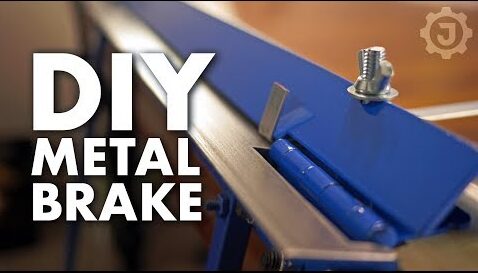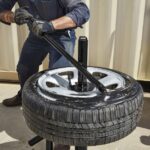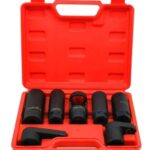A metal brake, also known as a box and pan brake or a sheet metal brake, is a versatile metalworking tool used to bend and shape sheet metal materials. It is an essential piece of equipment in metalworking shops, fabrication facilities, and construction sites. Metal brakes are designed to apply precise and controlled bending forces to flat sheets of metal, allowing for the creation of various shapes and angles.
Metal brakes come in different types, each suited for specific applications and material thicknesses. The most common types include:
- Box and Pan Brakes: These are the most widely used metal brakes, featuring a hinged clamping mechanism that holds the sheet metal in place while a bending leaf or blade applies the desired bend angle.
- Press Brakes: Also known as brake presses, these are heavy-duty machines typically used for bending thicker and larger sheets of metal. They employ a hydraulic or mechanical system to exert substantial clamping and bending forces.
- Portable Brakes: As the name suggests, these are compact and lightweight metal brakes designed for on-site or field applications where mobility is required.
Metal brakes are versatile tools with a wide range of applications in various industries, including:
- Fabrication of HVAC (Heating, Ventilation, and Air Conditioning) ductwork and components
- Manufacturing of metal enclosures, cabinets, and housings
- Production of architectural metal components, such as flashing, trim, and siding
- Creation of custom metal parts and prototypes for various industries
- Repair and maintenance of existing metal structures or equipment
With their ability to precisely bend and shape sheet metal, metal brakes are invaluable tools for metalworkers, fabricators, and contractors, enabling them to create a vast array of metal products and components with exceptional accuracy and efficiency.
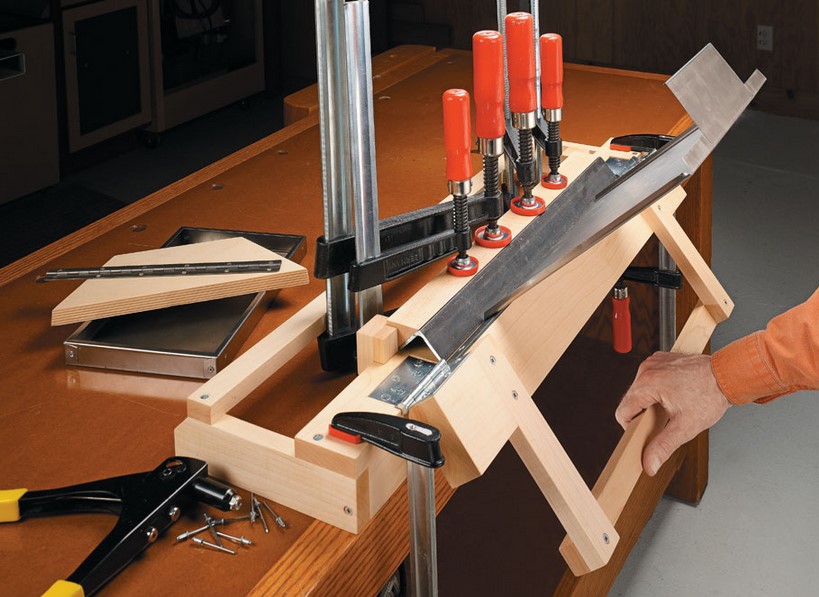
Table of Contents
Working Principle of Metal Brakes
Metal brakes are machines designed to bend and deform metal sheets or plates into desired shapes through the application of controlled force. The working principle of metal brakes revolves around the concept of plastic deformation, where the metal material is subjected to stresses beyond its yield strength, causing permanent deformation.
The core component of a metal brake is the bending beam or brake edge, which is a sturdy, precision-ground steel bar. When the metal sheet is positioned over the bending beam and the brake is actuated, a powerful clamping force is exerted on the sheet, pressing it against the bending beam. This clamping force is typically generated by a hydraulic or mechanical system, ensuring precise control over the applied pressure.
As the clamping force increases, the metal sheet experiences compressive stress on the side facing the bending beam and tensile stress on the opposite side. When the applied stress exceeds the yield strength of the metal, plastic deformation occurs, causing the sheet to bend permanently around the bending beam’s edge.
The degree of bending and the resulting angle are determined by several factors, including the thickness of the metal sheet, its material properties (such as yield strength and ductility), and the geometry of the bending beam. Precise control over these parameters allows metal brakes to produce consistent and accurate bends, enabling the fabrication of various metal components and structures.
The deformation process in metal brakes is a combination of bending and stretching. As the metal sheet bends around the bending beam, the material on the outer radius of the bend experiences tensile forces, causing it to stretch and elongate. Conversely, the material on the inner radius of the bend is compressed, resulting in compressive deformation. This balanced interplay of tensile and compressive forces facilitates the controlled plastic deformation of the metal sheet.
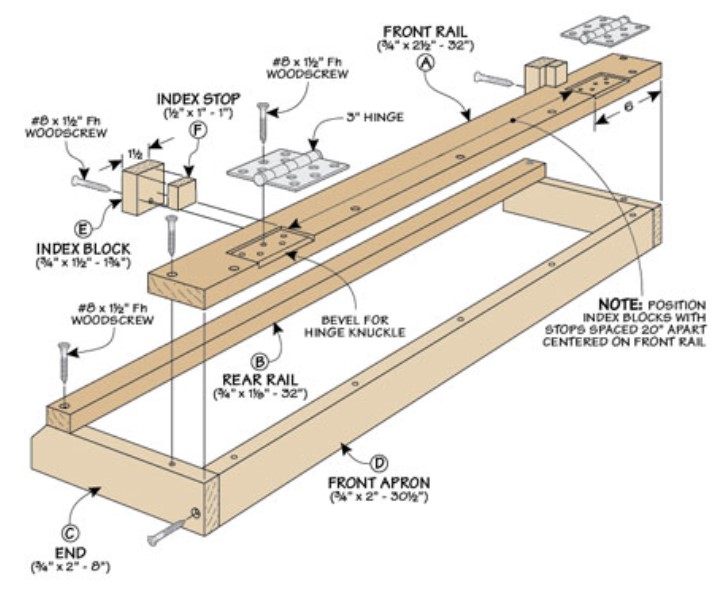
Materials Used in Metal Brakes
Metal brakes are typically constructed from durable and wear-resistant materials to ensure reliable performance and longevity. The choice of materials is crucial as they need to withstand high stresses, friction, and potential deformation during the bending process.
Common Materials
One of the most commonly used materials for metal brakes is cast iron. Cast iron offers excellent wear resistance, high compressive strength, and good machinability. It is often used for the construction of the brake’s body, jaws, and other critical components.
Alloy steels are another popular choice due to their high strength, toughness, and resistance to fatigue and wear. Different grades of alloy steels, such as tool steels or high-carbon steels, may be employed depending on the specific requirements of the application.
In some cases, non-ferrous materials like aluminum alloys or brass may be used for certain components of the metal brake. These materials offer advantages such as lighter weight, corrosion resistance, or specific mechanical properties.
Properties Required
The materials used in metal brakes must possess several key properties to ensure optimal performance and durability. Some of the essential properties include:
- High strength and toughness to withstand the forces involved in bending and forming operations.
- Wear resistance to minimize abrasion and maintain dimensional accuracy over time.
- Fatigue resistance to withstand cyclic loading without failure.
- Hardness to resist deformation and maintain a sharp edge for precise bending.
- Machinability for ease of manufacturing and maintenance.
Material Selection Criteria
The selection of materials for metal brakes involves careful consideration of various factors, including:
- Application requirements: The specific application, such as the type of metal being bent, the thickness, and the desired bend angles, will influence the material choice.
- Operating conditions: Factors like temperature, corrosive environments, or exposure to chemicals may necessitate the use of materials with specific properties.
- Cost and availability: While performance is crucial, the cost and availability of materials must also be considered for economic viability.
- Maintenance and replacement: Ease of maintenance and the availability of replacement parts should be evaluated for long-term operation.
By carefully selecting the appropriate materials based on these criteria, manufacturers can ensure that metal brakes deliver reliable and consistent performance while maximizing their service life and minimizing downtime.
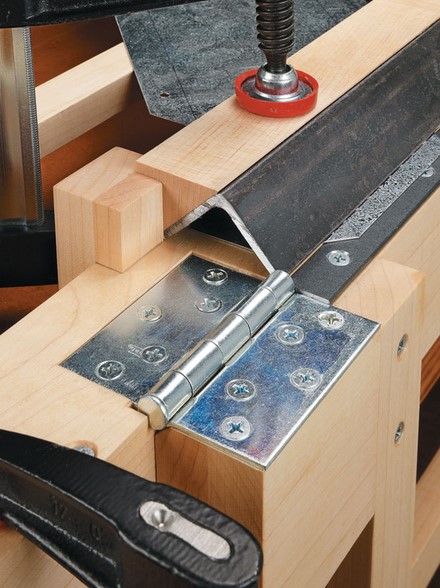
Types of Metal Brakes
Metal brakes can be broadly classified into several types based on their design, operation, and intended applications. Some of the commonly used types of metal brakes include:
Press Brakes
Press brakes, also known as brake presses or bending brakes, are among the most widely used metal brakes. They employ a punch and die mechanism to bend and form metal sheets or plates. Press brakes are available in various sizes and capacities, ranging from small manual units to large, computer-controlled machines used in industrial settings. They are versatile and can produce a wide range of bends, including air bends, coining, and bottoming.
Box and Pan Brakes
Box and pan brakes are specialized metal brakes designed for forming box-shaped or tray-like components from metal sheets. These brakes feature a series of finger-like tools that progressively bend the metal sheet into the desired shape. Box and pan brakes are commonly used in the fabrication of enclosures, cabinets, and other similar products.
Portable Brakes
Portable brakes, as the name suggests, are compact and lightweight metal brakes designed for on-site or field applications. These brakes are often hand-operated or powered by small electric motors, making them highly mobile and convenient for use in remote locations or tight spaces. Portable brakes are commonly used for smaller bending jobs or in situations where a larger, stationary brake is not practical.
Rotary Bending Machines
Rotary bending machines, also known as roll benders or roller benders, are metal brakes that use a series of rollers to progressively bend and form metal sheets or plates into curved or cylindrical shapes. These machines are particularly useful for creating curved components, such as exhaust pipes, handrails, or decorative architectural elements.
Hydraulic Brakes
Hydraulic brakes utilize hydraulic cylinders and pistons to generate the force required for bending metal sheets or plates. These brakes offer precise control over the bending process and can handle thicker and more robust materials. Hydraulic brakes are commonly found in industrial settings and are often computer-controlled for enhanced accuracy and repeatability.
Each type of metal brake has its unique advantages and is suited for specific applications or material requirements. The choice of metal brake depends on factors such as the desired bend geometry, material thickness, production volume, and available workspace.
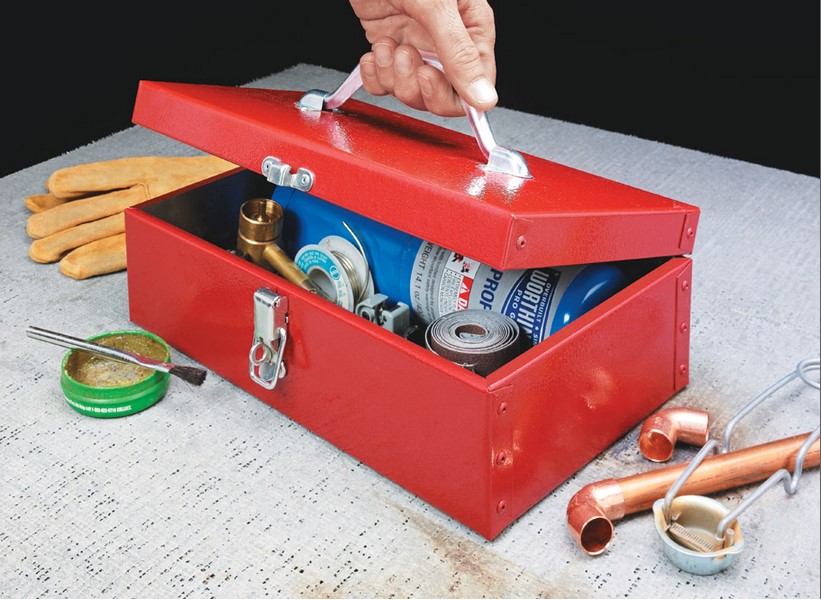
Metal Brake Design and Construction
Metal brakes are designed to be robust and durable machines capable of exerting significant force to bend and shape metal sheets and plates. The construction typically involves a sturdy frame made of heavy-duty steel or cast iron, providing a solid foundation for the bending operation.
The main components of a metal brake include:
- Frame: The frame is the backbone of the machine, ensuring rigidity and stability during operation. It is typically made of thick steel plates or cast iron and is designed to withstand the immense forces involved in bending metal.
- Bending Beam: Also known as the upper beam or ram, the bending beam is the movable component that applies the bending force to the metal workpiece. It is typically made of hardened steel and features a precise radius or nose to create the desired bend angle.
- Clamping Bed: The clamping bed, or lower beam, is the surface on which the metal workpiece rests during the bending process. It is often made of hardened steel or cast iron and may feature grooves or slots to accommodate different workpiece thicknesses and shapes.
- Hydraulic or Mechanical Drive System: Metal brakes can be powered by either hydraulic or mechanical drive systems. Hydraulic systems use pressurized fluid to generate the bending force, while mechanical systems employ gears, levers, or eccentric shafts to convert rotational motion into linear motion for bending.
- Controls and Gauges: Modern metal brakes are equipped with various controls and gauges to ensure precise and consistent bending. These may include digital displays for setting the bend angle, depth controls, and safety switches or emergency stop buttons.
Design considerations for metal brakes include:
- Bending Capacity: The maximum thickness and tensile strength of the metal that the brake can bend effectively, determined by the machine’s overall size and power.
- Bending Length: The maximum length of the workpiece that can be accommodated, based on the width of the clamping bed and bending beam.
- Precision and Accuracy: The ability to produce consistent and accurate bends, often achieved through precise machining, rigid construction, and calibrated controls.
- Ergonomics and Operator Safety: Features such as foot pedals, hand controls, and safety guards to protect operators from pinch points, falling workpieces, and other potential hazards.
- Portability and Mobility: Some metal brakes are designed to be portable or mobile, with built-in wheels or lifting points for easy transportation and positioning.
Safety features in metal brake design may include:
- Emergency Stop Buttons: Easily accessible buttons or switches that immediately halt the bending operation in case of an emergency.
- Light Curtains or Barriers: Optical or physical barriers that detect the presence of an operator’s hands or body parts in the bending area and prevent the machine from operating.
- Guarding and Shielding: Physical guards or shields that cover potential pinch points, moving parts, or areas where metal chips or debris may be ejected.
- Lockout/Tagout Systems: Mechanisms that allow operators to safely lock and tag out the machine’s power sources during maintenance or repair operations.
By incorporating robust construction, precise components, and comprehensive safety features, metal brake manufacturers strive to create reliable and user-friendly machines that can handle demanding bending applications while prioritizing operator safety.
Metal Brake Operation and Setup
Metal brake operation involves setting up the machine properly, ensuring the right tooling is in place, and following safety protocols. Setting up a metal brake correctly is crucial for achieving accurate bends and preventing material deformation or operator injury.
Setup Procedures
- Inspect the Machine: Before starting, inspect the metal brake for any visible damage, loose parts, or leaks. Ensure all safety guards and emergency stop buttons are functioning correctly.
- Prepare the Workpiece: Measure the workpiece dimensions accurately and mark the desired bend lines. Clean the material surface to remove any debris or contaminants that could affect the bending process.
- Adjust the Brake: Set the appropriate bend angle, bend radius, and depth of the brake based on the workpiece material, thickness, and desired bend specifications. Consult the machine’s manual or reference charts for accurate settings.
- Install Tooling: Select the correct punch and die set for the job. Ensure they are compatible with the material thickness and bend radius requirements. Securely install the tooling in the brake, following the manufacturer’s instructions.
- Align the Workpiece: Position the workpiece correctly on the brake bed, aligning the bend line with the edge of the punch. Use material stops, gauges, or clamping devices to secure the workpiece in place and prevent it from shifting during the bending process.
Tooling
Proper tooling selection is essential for achieving clean, accurate bends. Metal brakes typically use a punch and die set, with various profiles available for different bend geometries and material thicknesses. Common tooling options include:
- Wipe-down tools: Used for creating air bends or open hems.
- Gooseneck tools: Designed for box or pan bending operations.
- Offset tools: Suitable for creating offsets or joggle bends.
- Acute angle tools: Used for bending materials at tight angles.
Operator Safety
Metal brake operation involves handling heavy materials and applying significant force, making safety a top priority. Operators should follow these safety guidelines:
- Wear appropriate personal protective equipment (PPE), such as safety glasses, gloves, and steel-toed boots.
- Keep hands and body parts clear of the bending area during operation.
- Use proper lifting techniques when handling heavy workpieces.
- Ensure the machine is securely anchored to the floor to prevent tipping or movement during operation.
- Follow lockout/tagout procedures when performing maintenance or adjustments.
- Maintain a clean and organized work area around the metal brake.
By following proper setup procedures, using the right tooling, and adhering to safety protocols, operators can efficiently and safely operate metal brakes, producing high-quality bends with minimal risk of injury or material damage.
Applications of Metal Brakes
Metal brakes are versatile machines used across various industries for bending and forming metal sheets, plates, and bars into desired shapes. Their applications span several sectors, including manufacturing, construction, automotive, aerospace, and more.
Industries:
- Manufacturing: Metal brakes are essential in the manufacturing industry for fabricating metal components, enclosures, panels, and housings for various products, such as appliances, electronics, and machinery.
- Construction: The construction industry relies heavily on metal brakes for shaping and forming metal sheets used in roofing, siding, ductwork, and architectural metalwork.
- Automotive: Automotive manufacturers utilize metal brakes to form and bend metal sheets for vehicle body panels, chassis components, and other structural elements.
- Aerospace: The aerospace industry employs metal brakes to shape and form metal components used in aircraft fuselages, wings, and other critical structures, ensuring precision and reliability.
Product Manufacturing:
Metal brakes are instrumental in the manufacturing of a wide range of products, including:
- HVAC ductwork and fittings
- Architectural metalwork (e.g., railings, awnings, and decorative elements)
- Enclosures and cabinets for electrical and electronic equipment
- Metal furniture components
- Automotive body panels and structural components
- Aerospace parts and components
Benefits:
The use of metal brakes in various industries offers several benefits:
- Versatility: Metal brakes can handle a variety of materials, including mild steel, stainless steel, aluminum, and other metal alloys, allowing for diverse applications.
- Precision: Modern metal brakes are equipped with advanced controls and measurement systems, ensuring accurate and consistent bending and forming of metal components.
- Efficiency: Metal brakes streamline the manufacturing process by enabling the rapid and efficient shaping of metal components, reducing production time and costs.
- Customization: Metal brakes allow for the creation of custom-shaped components, enabling manufacturers to meet specific design requirements and product specifications.
- Durability: Products formed using metal brakes often exhibit superior strength and durability, making them suitable for applications that require structural integrity and longevity.
Metal brakes play a crucial role in various industries, enabling the efficient and precise shaping of metal components for a wide range of products, from everyday household items to complex aerospace structures.
Metal Brake Maintenance and Troubleshooting
Regular maintenance is crucial for ensuring the longevity and optimal performance of metal brakes. Establishing a comprehensive maintenance schedule can help prevent breakdowns, minimize downtime, and extend the lifespan of the equipment.
Maintenance Schedules
A typical maintenance schedule for metal brakes may include the following tasks:
- Daily Inspections: Before starting work, visually inspect the brake for any signs of wear, damage, or loose components. Check for proper lubrication and ensure that all safety guards are in place.
- Weekly Cleaning: Thoroughly clean the brake and its surrounding area to remove any accumulated debris, metal shavings, or contaminants that could interfere with its operation.
- Monthly Lubrication: Apply recommended lubricants to all moving parts, pivot points, and sliding surfaces to minimize friction and wear.
- Quarterly Adjustments: Check and adjust the brake’s alignment, clearances, and settings according to the manufacturer’s specifications to maintain accurate and consistent performance.
- Annual Overhaul: Perform a comprehensive inspection and overhaul of the entire brake system. Replace worn or damaged components, such as brake pads, linings, or bearings, as needed.
Common Issues
Despite proper maintenance, metal brakes may encounter various issues over time. Some common problems include:
- Wear and Tear: Metal brakes are subject to wear due to the constant friction and stress during operation. Brake pads, linings, and other components may need to be replaced periodically.
- Misalignment: Improper alignment of the brake components can lead to uneven wear, decreased efficiency, and potential damage.
- Lubrication Problems: Insufficient or excessive lubrication can cause increased friction, premature wear, or contamination issues.
- Electrical or Hydraulic Failures: For brakes with electrical or hydraulic systems, failures in these components can prevent proper brake operation.
Troubleshooting Tips
If you encounter issues with your metal brake, here are some troubleshooting tips:
- Refer to the Manufacturer’s Manual: Consult the manufacturer’s manual for specific troubleshooting guidelines, recommended maintenance procedures, and diagnostic steps.
- Inspect for Visible Damage: Carefully inspect the brake for any signs of physical damage, such as cracks, dents, or loose components, which may indicate the root cause of the problem.
- Check Lubrication Levels: Ensure that all lubrication points are properly lubricated according to the manufacturer’s recommendations.
- Test Electrical or Hydraulic Systems: If applicable, check the electrical or hydraulic systems for proper operation, including testing switches, sensors, and fluid levels.
- Adjust or Replace Worn Components: If worn or damaged components are identified, adjust or replace them as necessary, following the manufacturer’s instructions.
- Seek Professional Assistance: If the issue persists or you are unable to identify the root cause, consider seeking assistance from a qualified technician or the manufacturer’s service team.
By following a comprehensive maintenance schedule and promptly addressing any issues, you can ensure the safe and efficient operation of your metal brake, minimizing downtime and maximizing productivity.
Safety Considerations for Metal Brakes
Operating metal brakes requires adhering to strict safety protocols to prevent accidents and injuries. Proper training, use of personal protective equipment (PPE), and compliance with safety regulations are crucial for ensuring a safe working environment.
Operator Safety:
- Training: All operators must receive comprehensive training on the safe operation of metal brakes, including machine setup, loading and unloading procedures, and emergency stop procedures.
- Machine Guarding: Metal brakes should be equipped with adequate guarding mechanisms to protect operators from pinch points, shearing hazards, and other potential dangers.
- Lockout/Tagout: Implement lockout/tagout procedures to prevent accidental machine startup during maintenance, repair, or setup operations.
- Ergonomics: Ensure proper ergonomic practices are followed to minimize strain and fatigue, such as adjusting the machine height and providing anti-fatigue mats.
Personal Protective Equipment (PPE):
- Eye Protection: Operators must wear safety glasses or face shields to protect against flying debris, metal shavings, or sparks.
- Hand Protection: Wear appropriate cut-resistant gloves to protect hands from sharp edges and pinch points.
- Foot Protection: Steel-toed safety shoes or boots should be worn to prevent foot injuries from falling objects or heavy workpieces.
- Hearing Protection: Depending on the noise levels, operators may need to wear earplugs or earmuffs to protect their hearing.
Safety Regulations:
Metal brake operations must comply with relevant safety regulations and standards set by organizations such as the Occupational Safety and Health Administration (OSHA) or local authorities. These regulations cover aspects like machine guarding, electrical safety, and workplace safety practices.
Employers should conduct regular safety inspections, provide ongoing safety training, and ensure that all safety protocols are strictly followed. By prioritizing safety, employers can create a secure working environment and minimize the risk of accidents and injuries associated with metal brake operations.
Future Trends and Developments in Metal Brakes
The metal brake industry is continuously evolving to meet the changing demands of various industries and incorporate emerging technologies. One significant trend is the integration of digital technologies, such as computer-aided design (CAD) and computer-aided manufacturing (CAM), to improve the design and production processes. These technologies enable manufacturers to create more precise and efficient metal brake designs, reducing waste and increasing productivity.
Another emerging trend is the development of automated and robotized metal brake systems. These systems can operate with minimal human intervention, increasing efficiency, consistency, and safety in the manufacturing process. Automated systems also allow for greater flexibility in production, enabling manufacturers to quickly adapt to changing market demands.
The industry is also exploring the use of advanced materials, such as high-strength alloys and composites, to enhance the performance and durability of metal brakes. These materials can withstand higher loads and extreme conditions, making them suitable for applications in industries like aerospace and automotive.
Sustainability is another key focus area, with manufacturers seeking to reduce the environmental impact of metal brake production and operation. This includes the development of energy-efficient processes, the use of recyclable materials, and the implementation of waste reduction strategies.
Furthermore, the integration of Internet of Things (IoT) technology and predictive maintenance strategies is gaining traction in the metal brake industry. IoT-enabled metal brakes can provide real-time data on performance, wear, and maintenance requirements, allowing for proactive maintenance and reducing downtime.
As industries continue to evolve and new applications emerge, the metal brake industry will likely witness further advancements in design, materials, and manufacturing processes to meet the ever-changing demands of various sectors.

